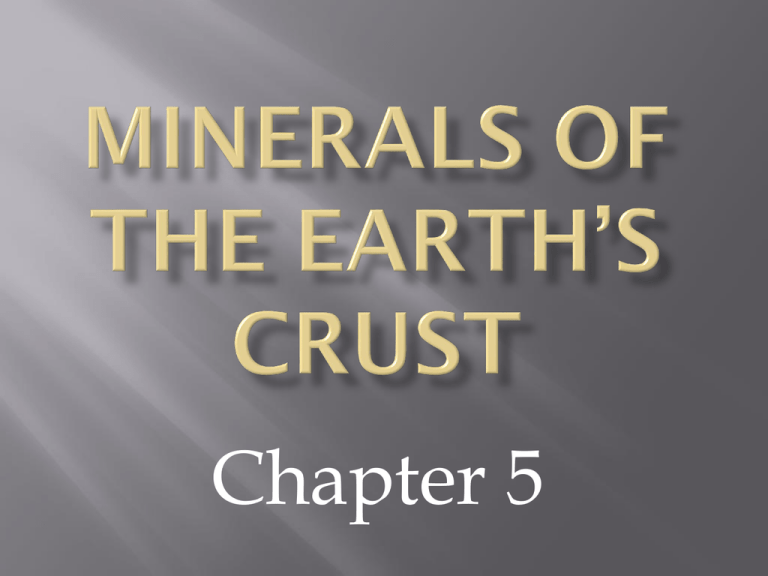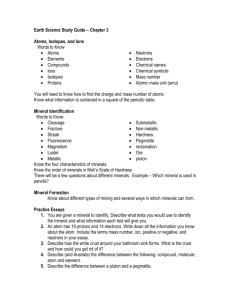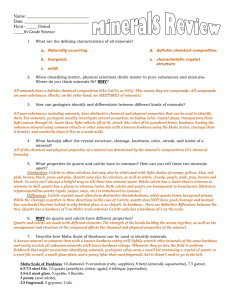Minerals of the Earth*s crust
advertisement

Chapter 5 Chapter 5 Minerals of Earth’s Crust SES2d. Associate specific plate tectonic settings with the production of particular groups of igneous and metamorphic rocks and mineral resources SES3d. Explain the processes that transport and deposit material in terrestrial and marine sedimentary basins, which result, over time, in sedimentary rock. Chapter 5 Section 1 What Is a Mineral? To be a mineral, a substance must have four characteristics: it must be inorganic—it cannot be made of or by living things; it must occur naturally—it cannot be man-made; it must be a crystalline solid; it must have a consistent chemical composition. Chapter 5 Section 1 What Is a Mineral? The diagram below shows the four characteristics of minerals. Chapter 5 Section 1 What Is a Mineral? The 20 most common minerals are called rockforming minerals because they form the rocks that make up Earth’s crust. Ten minerals are so common that they make up 90% of Earth’s crust. These minerals are quartz, orthoclase, plagioclase, muscovite, biotite, calcite, dolomite, halite, gypsum, and ferromagnesian minerals. All minerals can be classified into two main groups—silicate minerals and nonsilicate minerals—based on their chemical compositions. Chapter 5 Section 1 What Is a Mineral? Silicate Minerals silicate mineral a mineral that contains a combination of silicon and oxygen, and that may also contain one or more metals Common silicate minerals include quartz, feldspars, micas ,and ferromagnesian minerals, such as amphiboles, pyroxenes, and olivines. Silicate minerals make up 96% of Earth’s crust. Quartz and feldspar alone make up more than 50% of the crust. Chapter 5 Section 1 What Is a Mineral? Nonsilicate Minerals nonsilicate mineral a mineral that does not contain compounds of silicon and oxygen Nonsilicate minerals comprise about 4% of Earth’s crust. Nonsilicate minerals are organized into six major groups based on their chemical compositions. The six major groups of nonsilicate minerals are carbonates, halides, native elements, oxides, sulfates, and sulfides. Chapter 5 Section 1 What Is a Mineral? Each type of mineral is characterized by a specific geometric arrangement of atoms, or its crystalline structure. crystal a solid whose atoms, ions, or molecules are arranged in a regular, repeating pattern One way that scientists study the structure of crystals is by using X rays. X rays that pass through a crystal and strike a photographic plate produce an image that shows the geometric arrangement of the atoms in the crystal. Chapter 5 Section 1 What Is a Mineral? Even though there are many kinds of silicate minerals, their crystalline structure is made up of the same basic building blocks—silicon-oxygen tetrahedra. silicon-oxygen tetrahedron the basic unit of the structure of silicate minerals; a silicon ion chemically bonded to and surrounded by four oxygen ions Isolated Tetrahedral Silicates In minerals that have isolated tetrahedra, only atoms other than silicon and oxygen atoms like silicon-oxygen tetrahedra together. Olivine is an isolated tetrahedral silicate. Chapter 5 Section 1 What Is a Mineral? The diagram below shows the tetrahedral arrangement of isolated tetrahedral silicate minerals. Chapter 5 Section 1 What Is a Mineral? Ring Silicates Ring silicates form when shared oxygen atoms join the tetrahedra to form three-, four-, or six-sided rings. Beryl and tourmaline are ring silicates. Single-Chain Silicates In single-chain silicates, each tetrahedron is bonded to two others by shared oxygen atoms. Most double-chain silicates are called pyroxenes. Chapter 5 Section 1 What Is a Mineral? The diagram below shows the tetrahedral arrangement of ring silicate minerals. Chapter 5 Section 1 What Is a Mineral? The diagram below shows the tetrahedral arrangement of single-chain silicate minerals. Chapter 5 Section 1 What Is a Mineral? Double-Chain Silicates In double-chain silicates, two single chains of tetrahedra bond to each other. Most double-chain silicates are called amphiboles. Sheet Silicates In the sheet silicates, each tetrahedron shares three oxygen atoms with other tetrahedra. The fourth oxygen atom bonds with an atom of aluminum or magnesium, which joins the sheets together. The mica minerals, such as muscovite and biotite, are sheet silicates. Chapter 5 Section 1 What Is a Mineral? The diagram below shows the tetrahedral arrangement of doublechain silicate minerals. Chapter 5 Section 1 What Is a Mineral? The diagram below shows the tetrahedral arrangement of sheet silicate minerals. Chapter 5 Section 1 What Is a Mineral? Framework Silicates In the framework silicates, each tetrahedron is bonded to four neighboring tetrahedra to form a threedimensional network. Frameworks that contain only silicon-oxygen tetrahedra are the mineral quartz. Other framework silicates contain some tetrahedra in which atoms of aluminum or other metals substitute for some of the silicon atoms. Quartz and feldspars are framework silicates. Chapter 5 Section 1 What Is a Mineral? The diagram below shows the tetrahedral arrangement of framework silicate minerals. Chapter 5 Section 1 What Is a Mineral? Because nonsilicate minerals have diverse chemical compositions, nonsilicate minerals display a vast variety of crystalline structures. Common crystalline structures for nonsilicate minerals include cubes, hexagonal prisms, and irregular masses. The structure of a nonsilicate crystal determines the mineral’s characteristics. In the crystal structure called closest packing, each metal atom is surrounded by 8 to 12 other metal atoms that are as close to each other as the charges of the atomic nuclei will allow. Chapter 5 Section 2 Identifying Minerals Color While color is a property that is easily observed, it is unreliable for the identification of minerals. The color of a mineral sample can be affected by the inclusion of impurities or by weathering processes. Streak streak the color of a mineral in powdered form Streak is more reliable than color for the identification of minerals. Streak is determined by rubbing some of the mineral against an unglazed ceramic tile called a streak plate. Chapter 5 Section 2 Identifying Minerals Luster luster the way in which a mineral reflects light A mineral is said to have a metallic luster if the mineral reflects light as a polished metal does. All other minerals have nonmetallic luster. There are several types of nonmetallic luster, including glassy, waxy, pearly, brilliant, and earthy. Chapter 5 Section 2 Identifying Minerals Cleavage and Fracture cleavage in geology, the tendency of a mineral to split along specific planes of weakness to form smooth, flat surfaces fracture the manner in which a mineral breaks along either curved or irregular surfaces Uneven or irregular fractures have rough surfaces. Splintery or fibrous fractures look like a piece of broken wood. Curved surfaces are conchoidal fractures . Chapter 5 Section 2 Identifying Minerals Hardness The measure of the ability of a mineral to resist scratching is called hardness. Hardness does not mean “resistance to cleavage or fracture.” The hardness of a mineral can be determined by comparing the mineral to minerals of Mohs hardness scale. Mohs hardness scale the standard scale against which the hardness of minerals is rated. The strength of the bonds between the atoms that make up a mineral’s internal structure determines the hardness of a mineral. Chapter 5 Section 2 Identifying Minerals The diagram below shows Mohs Hardness Scale. Chapter 5 Section 2 Identifying Minerals Crystal Shape A mineral crystal forms in one of six basic shapes. A certain mineral always has the same general shape because the atoms that form the mineral’s crystals always combine in the same geometric pattern. The six basic crystal systems are the isometric or cubic system, the orthorhombic system, the tetragonal system, the hexagonal system, the monoclinic system, and the triclinic system. Chapter 5 Section 2 Identifying Minerals The diagram below shows the six basic crystal systems. Chapter 5 Section 2 Identifying Minerals Density density the ratio of the mass of a substance to the volume of a substance; commonly expressed as grams per cubic centimeter for solids The density of a mineral depends on the kinds of atoms in the mineral and on how closely the atoms are packed. density = mass volume Chapter 5 Section 2 Identifying Minerals A few minerals have some additional, special properties that can help identify those minerals. Fluorescence and Phosphorescence The ability to glow under ultraviolet light is called fluorescence. Fluorescent minerals absorb ultraviolet light and then produce visible light of various colors. The property of some minerals to glow after the ultraviolet light is turned off is called phosphorescence. Chapter 5 Section 2 Identifying Minerals Chatoyancy and Asterism In reflected light, some minerals display a silky appearance that is called chatoyancy, or the cat’s-eye effect. A similar effect called asterism is the phenomenon in which a six-sided star appears when a mineral reflects light. Double Refraction The property of some minerals, particularly some forms of calcite, to produce a double image of any object viewed through the mineral is called double refraction. Chapter 5 Section 2 Identifying Minerals Magnetism Minerals that are attracted to magnets display the property of magnetism. These minerals may be magnetic themselves. In general, nonsilicate minerals that contain iron are more likely to be magnetic than silicate minerals are. Radioactivity The property known as radioactivity results as unstable nuclei decay over time into stable nuclei by releasing particles and energy. A Geiger counter is used to detect the released particles and, thus, to identify minerals that are radioactive. Chapter 5 Maps in Action Chapter 5 1. Coal is A. organic and a mineral. B. inorganic and a mineral. C. organic and not a mineral. D. inorganic and not a mineral. Chapter 5 1. Coal is A. organic and a mineral. B. inorganic and a mineral. C. organic and not a mineral. D. inorganic and not a mineral. Chapter 5 2. Which of the following is one of the 10 rockforming minerals that make up 90% of Earth’s crust? F. G. H. I. quartz fluorite copper talc Chapter 5 2. Which of the following is one of the 10 rockforming minerals that make up 90% of Earth’s crust? F. G. H. I. quartz fluorite copper talc Chapter 5 3. Minerals can be identified by all of the following properties except A. color. B. streak. C. hardness. D. luster. Chapter 5 3. Minerals can be identified by all of the following properties except A. color. B. streak. C. hardness. D. luster. Chapter 5 4. All minerals in Earth’s crust F. G. H. I. have a crystalline structure. are classified as ring silicates. are classified as pyroxenes or amphiboles. have no silicon in their tetrahedral structure. Chapter 5 4. All minerals in Earth’s crust F. G. H. I. have a crystalline structure. are classified as ring silicates. are classified as pyroxenes or amphiboles. have no silicon in their tetrahedral structure. Chapter 5 5. Which mineral can be scratched by a fingernail that has a hardness of 2.5 on the Mohs scale? A. diamond B. quartz C. topaz D. talc Chapter 5 5. Which mineral can be scratched by a fingernail that has a hardness of 2.5 on the Mohs scale? A. diamond B. quartz C. topaz D. talc Chapter 5 6. Carbonates, halides, native elements, oxides, sulfates, and sulfides are classes of what mineral group? Chapter 5 6. Carbonates, halides, native elements, oxides, sulfates, and sulfides are classes of what mineral group? nonsilicate minerals Chapter 5 7. What mineral is made up of only the elements oxygen and silicon? Chapter 5 7. What mineral is made up of only the elements oxygen and silicon? quartz Chapter 5 8. What property is a mineral said to have when a person is able to view double images through it? Chapter 5 8. What property is a mineral said to have when a person is able to view double images through it? double refraction








